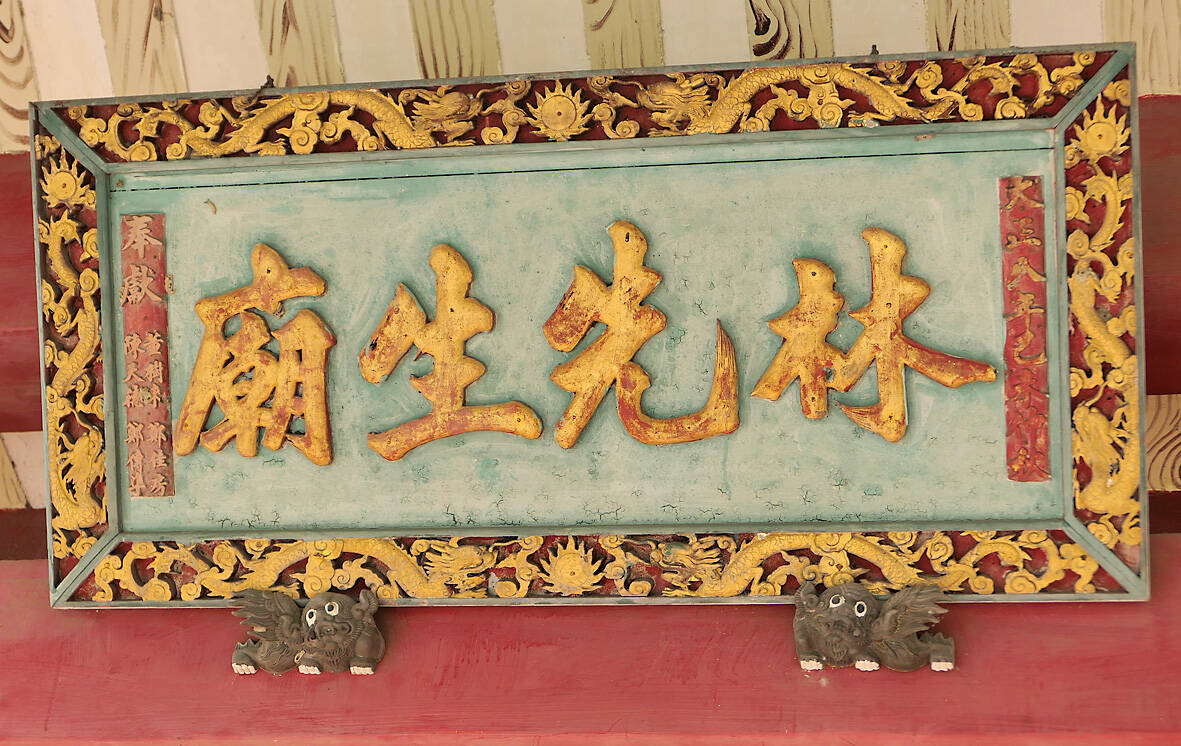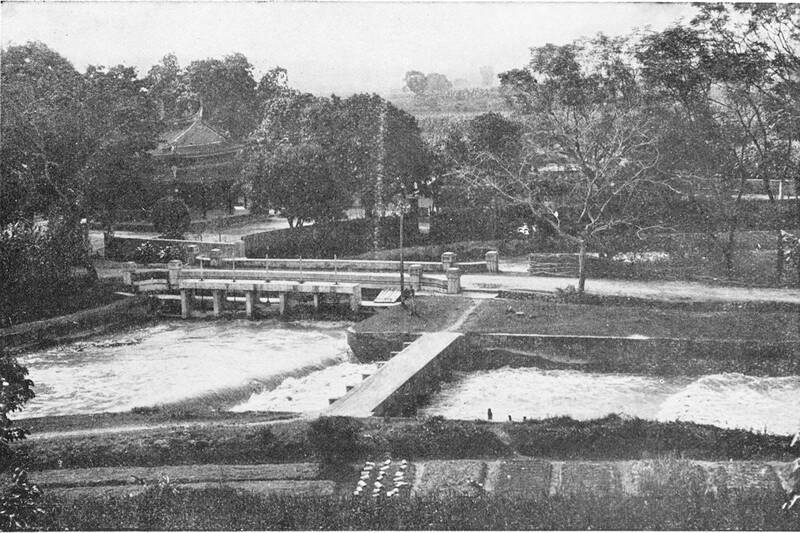Sept. 23 to Sept. 29
The construction of the Babao Irrigation Canal (八堡圳) was not going well. Large-scale irrigation structures were almost unheard of in Taiwan in 1709, but Shih Shih-pang (施世榜) was determined to divert water from the Jhuoshuei River (濁水溪) to the Changhua plain, where he owned land, to promote wet rice cultivation.
According to legend, a mysterious old man only known as Mr. Lin (林先生) appeared and taught Shih how to use woven conical baskets filled with rocks called shigou (石笱) to control water diversion, as well as other techniques such as surveying terrain by observing shadows during nighttime. It worked, and upon the canal’s completion in 1719, Shih prepared a substantial reward for Mr. Lin. However, the old man turned down the money and was never heard from again.

Photo courtesy of Ershuei Township Office
Located in today’s Ershuei Township (二水), the Babao Canal is among the oldest of its kind in Taiwan. It turned the Changhua plain into Taiwan’s top granary, much of the rice being exported to China, which was experiencing a population explosion. The canal contributed to the rise of Lukang (鹿港) as Taiwan’s second most prosperous city after Tainan. Shih spent his later years in Lukang, and his spirit tablet is worshiped in the town’s famous Tianhou Temple (天后宮).
The locals of Ershuei also never forgot about Mr. Lin. At some point, they built the Mr. Lin Temple (林先生廟) at the source of the canal. Shih is also honored there, as well as Huang Shih-ching (黃仕卿), who built the nearby Shiwujhuang Canal (十五庄圳), which the Japanese later renamed the Babao Second Canal and administered them under one system.
Both canals remained earthen structures until they were fortified with reinforced concrete in the 1960s. They are currently undergoing a second reinforcement process due to cracks and leaks in the concrete, with the latest phase completed last week.

Photo courtesy of Wikimedia Commons
RISE OF THE SHIH CLAN
Although the Qing Dynasty could not stem the migration of Han people to Taiwan during the 1700s, prospectors still had to obtain an official permit to claim “uncultivated” land outside of the delineated indigenous territory, writes Liou Yue-chia (劉育嘉) in The Development of Changhua County in the Qing Dynasty, 1723-1887 (清代彰化縣的開發). These permits often went to influential families, who then invited tenant farmers to till the land.
In central Taiwan, most permit holders were government officials or gentry. This included Shih Shih-pang, who was a distant relative of Shih Lang (施琅), the Qing admiral who destroyed the Tainan-based Kingdom of Tungning (東寧) in 1683 and convinced the emperor to annex Taiwan. Shih Lang made a fortune in Taiwan afterwards through what many believe to be questionable means, and he made sure that his extended family benefited, Liou writes.

Photo courtesy of National Changhua Life Arts Center
Shih Shih-pang’s father Shih Ping (施秉) participated in Shih Lang’s invasion of Taiwan, and was bestowed with an official title due to the campaign’s success. Through the family’s connections he became a successful sugar exporter in his hometown of Quanzhou, Fujian Province, and further increased his wealth through real estate, writes Huang Fu-san (黃富三) in Pioneer of Taiwan’s Wet Farming Expansion: A Family History of Shih Shih-pang (臺灣水田化運動先驅:施世榜家族史).
It’s unclear why the thriving Shih Ping had to leave for Taiwan, but Huang suggests that the government forcefully relocated him due to a local dispute he was involved in. Taiwan was a major sugar producer and Shih Ping was familiar with the industry, and with the backing of the Shih Lang, it probably wasn’t too risky of a move.
He and his family made the journey in 1693, settling in Kaohsiung’s Fengshan District (鳳山). At that time, Shih Shih-pang was 22 years old. The younger Shih officially established residence in Fengshan and passed the local imperial examinations.

Photo courtesy of Academia Sinica
ARDUOUS ENDEAVOR
The family continued with the sugar trade and about a decade later, they began investing in rice production in central Taiwan. It was a smart business move, since by this time, rice was replacing sugar as Taiwan’s most lucrative export.
The previous indigenous Babuza and Hoanya inhabitants engaged in shifting subsistence agriculture, which the Han arrivals emulated at first, writes Shih Jui-pin (石瑞彬) for the Taiwan Historica E-paper. As the settler population grew and the demand from China increased, many began switching to higher-yield wet paddy cultivation, at first with the use of irrigation ponds. But due to the lack of stable water sources across the plain, this method was not suitable for large-scale production.
The creation of a substantial irrigation canal would be costly and time consuming, but Shih Shih-pang believed it was worth it. Construction began in 1709 and took 10 years to complete, drawing water from the Jhuoshuei River and serving more than 19,000 hectares of land. It was named the Shih Family Canal (施厝圳), but by the 1800s it was more commonly referred to as the Babao Canal, in reference to the eight bao (堡, a Qing-era settlement unit) it passed through.
Not much is known of this Mr. Lin, and there’s doubt that he ever existed. The stories say that he was a refined man dressed in modest clothing, roaming the area drinking alcohol and composing poetry. Some believe that he was a water engineer under the Kingdom of Tungning who refused to work for the Qing, choosing to become a hermit instead.
Nearby landowners followed suit, building the Shiwujhuang Canal and Erba Canal (2八圳) in 1721. Shih later invested in the smaller Fuma Canal (福馬圳), which connected the system with the Dadu River (大肚溪) to the north.
CANAL MANAGEMENT
The construction of the canal was just the beginning, however, as it was another costly and taxing task to manage and maintain it.
The Shih family had to make sure that the canal was working at all times, making repairs whenever necessary, and also dealt with natural disasters and conflicts between farmers regarding water usage, Liou writes.
At this point, the Shihs were possibly the richest in Taiwan, writes Huang. Shih Shih-pang and his younger brother participated in the suppression of “Duck King” Chu Yi-kuei’s (朱一貴) rebellion in 1721, and afterward helped with clearing out the remaining rebels and the rebuilding effort.
Shih was rewarded with an official position for his achievements, eventually rising to vice-commander of the local military ward. As gentry, he did his part in contributing to Fengshan, Tainan, Changhua and his hometown in Quanzhou, funding schools, temples, bridges and other facilities. Huang writes that his main cause was promoting education. He was also a poet and writer, penning a compilation of indigenous customs in Pingtung.
The Shih family continued running the Babao and Fuma canals for more than a century. But while Shih Shih-pang’s descendants were active as scholars and officials and inherited his philanthropic spirit, they were not good at business. The family was not able to hold on to its wealth, sharply declining after the 1840s and losing much of their property.
In 1897, canal ownership was transferred to Lukang’s Koo Hsien-jung (辜顯榮), who enjoyed close ties with the Japanese government. Koo continued to run the canal after it became government property in 1905.
Taiwan in Time, a column about Taiwan’s history that is published every Sunday, spotlights important or interesting events around the nation that either have anniversaries this week or are tied to current events.

June 9 to June 15 A photo of two men riding trendy high-wheel Penny-Farthing bicycles past a Qing Dynasty gate aptly captures the essence of Taipei in 1897 — a newly colonized city on the cusp of great change. The Japanese began making significant modifications to the cityscape in 1899, tearing down Qing-era structures, widening boulevards and installing Western-style infrastructure and buildings. The photographer, Minosuke Imamura, only spent a year in Taiwan as a cartographer for the governor-general’s office, but he left behind a treasure trove of 130 images showing life at the onset of Japanese rule, spanning July 1897 to

One of the most important gripes that Taiwanese have about the Democratic Progressive Party (DPP) is that it has failed to deliver concretely on higher wages, housing prices and other bread-and-butter issues. The parallel complaint is that the DPP cares only about glamor issues, such as removing markers of Chinese Nationalist Party (KMT) colonialism by renaming them, or what the KMT codes as “de-Sinification.” Once again, as a critical election looms, the DPP is presenting evidence for that charge. The KMT was quick to jump on the recent proposal of the Ministry of the Interior (MOI) to rename roads that symbolize

On the evening of June 1, Control Yuan Secretary-General Lee Chun-yi (李俊俋) apologized and resigned in disgrace. His crime was instructing his driver to use a Control Yuan vehicle to transport his dog to a pet grooming salon. The Control Yuan is the government branch that investigates, audits and impeaches government officials for, among other things, misuse of government funds, so his misuse of a government vehicle was highly inappropriate. If this story were told to anyone living in the golden era of swaggering gangsters, flashy nouveau riche businessmen, and corrupt “black gold” politics of the 1980s and 1990s, they would have laughed.

In an interview posted online by United Daily News (UDN) on May 26, current Chinese Nationalist Party (KMT) Chairman Eric Chu (朱立倫) was asked about Taichung Mayor Lu Shiow-yen (盧秀燕) replacing him as party chair. Though not yet officially running, by the customs of Taiwan politics, Lu has been signalling she is both running for party chair and to be the party’s 2028 presidential candidate. She told an international media outlet that she was considering a run. She also gave a speech in Keelung on national priorities and foreign affairs. For details, see the May 23 edition of this column,